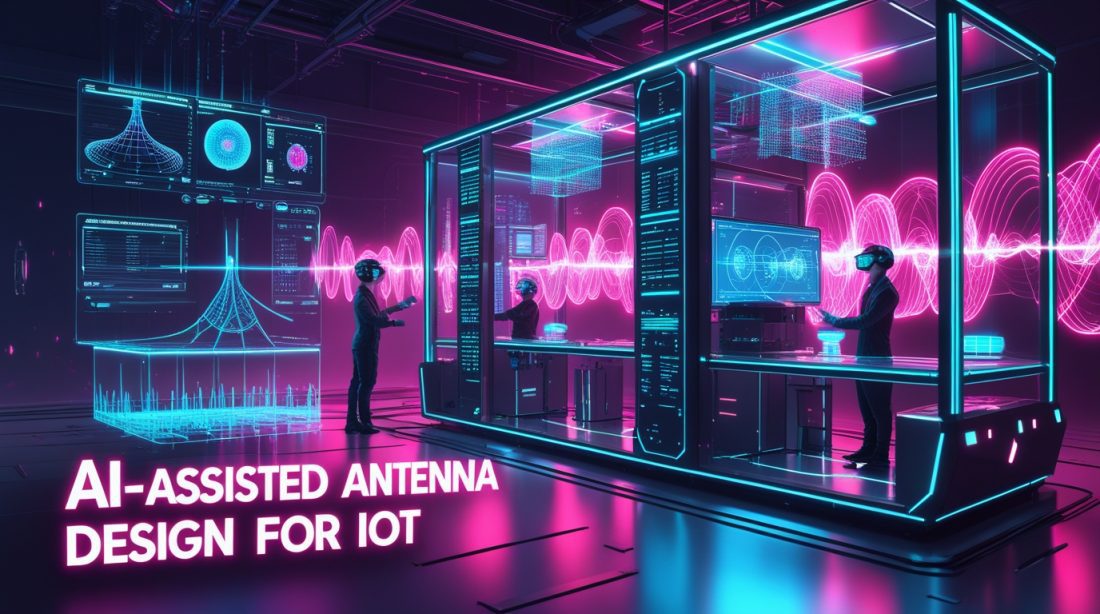IoT antenna shipments are projected to hit 13 billion units annually by 2030, a remarkable recovery despite post-pandemic challenges and inflationary pressures. This growth isn’t happening by accident—it’s being engineered through AI-assisted antenna design for IoT, which is fundamentally transforming how antennas are designed, optimized, and integrated across countless connected devices.
AI-Assisted Antenna Design for IoT: The Key to Scalable Wireless Innovation
The traditional antenna design process was notoriously complex, requiring extensive electromagnetic testing and manual iteration. AI has transformed this into an accelerated, precision-driven workflow that aligns perfectly with the massive scale of coming IoT deployments.
From Months to Minutes: The AI Design Revolution
AI-assisted antenna design software represents one of the most significant shifts in the industry’s history. As Dan Shey, Vice President at ABI Research, explains: “These tools help device OEMs virtually test antenna placement and performance based on board size and electronic design. They can also assist with component selection and enable direct ordering of antennas and ancillary parts” .
Leading platforms like Ignion’s Oxion, Taoglas’ Antenna Integrator, and Kyocera AVX’s IoT Solution Optimizer are differentiated specifically by their AI capabilities . These systems can:
- Automatically generate and test thousands of design variations
- Predict performance characteristics without physical prototyping
- Optimize antenna placement for real-world operating conditions
Surrogate Optimization: Evolving Antenna Shapes
Beyond initial design, AI-driven surrogate optimization has revolutionized antenna performance enhancement. This technique builds a surrogate model that learns the search space characteristics using electromagnetic solvers, then drives optimization while minimizing expensive solver calls .
In practice, this enables engineers to start with a standard antenna design and evolve its shape to achieve target performance objectives. One demonstration transformed a standard triangular microstrip patch antenna, improving its bandwidth from 3% to 12% through AI-guided shape evolution . This double resonance achievement would have been exceptionally difficult to discover through traditional methods.
Market Dynamics: The Technologies and Segments Driving Growth
The path to 13 billion annual antenna shipments is paved with specific technologies and use cases that will dominate the next decade of IoT development.
Table: IoT Antenna Market Segmentation (2030 Projections)
The Bluetooth and Wi-Fi Dominance
More than 60% of the 13 billion antenna shipments will be for Bluetooth and Wi-Fi-enabled devices . This reflects the continued expansion of:
- Connected home devices including smart speakers, security systems, and appliances
- Wearables and hearables that have stabilized as essential consumer electronics
- Industrial IoT sensors that leverage ubiquitous wireless connectivity
The Cellular IoT Transformation
The cellular antenna market is experiencing a significant technology shift. Cat-1bis has “taken the market by storm as an inexpensive connectivity technology that significantly lowers device cost while leveraging worldwide 4G coverage,” according to Shey . This transition has a direct impact on antenna counts—where devices originally designed with between two and four antennas will now use only one when adopting Cat-1bis .
Regional Landscape: North America’s Leadership and Global Growth Patterns
While global growth is forecast, its distribution is uneven, reflecting regional technological capabilities and market maturity.
North America’s Sustained Dominance
North America will maintain its lead with roughly 30% of the global market share, driven by its strong consumer sector for wearables, hearables, and smart home devices . Despite lingering tariff and inflationary pressures that could depress demand, the region’s established tech ecosystem and early 5G deployment have positioned it for continued leadership.
Global Growth Patterns
Other regions show varying growth trajectories:
- Europe remains focused on microwave antenna advancements with key players like CommScope Holding, Infinite Electronics (RadioWaves), and Radio Frequency Systems driving innovation
- Asia-Pacific demonstrates rapid growth potential, particularly in Antenna in Package (AiP) technology, led by strong semiconductor industries and key players like TSMC, Samsung, and Huawei
Challenges and Constraints in the Antenna Market Growth Trajectory
Despite the optimistic forecast, the industry faces significant headwinds that could affect the pace of growth.
Cellular IoT and 5G Adoption Delays
The cellular IoT market specifically will continue to experience challenges due to:
- Delayed 5G IoT device adoption extending development timelines
- Slower-than-expected growth in electric vehicles and asset tracking applications
- High interest rates that have slowed antenna shipments for connected appliances
Technical and Material Constraints
For emerging technologies like Antenna in Package (AiP), significant challenges include:
- Material limitations requiring advanced materials that balance performance with cost-effectiveness
- Design complexity resulting in longer development cycles and higher costs
- Manufacturing precision that makes scaling production efficiently difficult
One industry insider shared, “We’re facing a fundamental tension between the demand for miniaturization and the physical limitations of electromagnetic performance. Each new generation of devices requires antennas to do more in less space, which invariably increases design complexity and cost.” This reflects the ongoing balancing act across the sector.
The Industrial Impact: Why This Matters Beyond Component Counts
The projection of 13 billion antenna shipments represents more than just component volume—it signals a fundamental shift in how industries approach connectivity.
From Component to System: The AI-Driven Future
AI is transforming antennas from isolated components into intelligent systems. The integration of machine learning and artificial neural networks enables smart antennas that adapt their radiation patterns in response to the surrounding signal environment . This adaptability enhances signal quality, reduces interference, and improves overall communication performance.
Accelerating Innovation Cycles
The efficiency gains from AI-driven design extend beyond cost reduction. As noted in industry analysis, “AI-driven engineering enables scalable, efficient and agile solutions” that allow engineers to conduct “what-if” analyses without exhaustive simulations rapidly . This acceleration is crucial for keeping pace with the explosive growth of IoT applications across industries.
The cellular IoT market faces headwinds from delayed 5G IoT device adoption and slower growth in EVs and asset tracking. Additionally, technical complexities in antenna design and material limitations could constrain growth.
Fast Facts
IoT antenna shipments will reach 13 billion units by 2030, with Bluetooth and Wi-Fi antennas comprising over 60% of the total. This growth is enabled by AI-assisted antenna design for IoT, which is revolutionizing antenna development through faster, smarter, and more scalable workflows. Though challenges remain in cellular IoT adoption and technical complexities, North America is expected to lead with 30% market share, driven by strong consumer demand for connected devices.
Stay ahead of industry transformations. Subscribe to our newsletter for monthly analysis on how AI is reshaping technology manufacturing.



